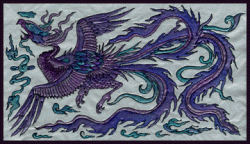January 10
 According to their creation narrative, the Chinook people were the offspring of a thunderbird who nested her eggs on a mountain occupied by an ogress. The ogress threw the eggs from the mountain side, but the hatchlings survived and took their wives in the valley below.
According to their creation narrative, the Chinook people were the offspring of a thunderbird who nested her eggs on a mountain occupied by an ogress. The ogress threw the eggs from the mountain side, but the hatchlings survived and took their wives in the valley below.By the beginning of the 19th century of the Christian calendar, the Clackamas -- one of the numerous Chinook tribes -- flourished in the area around Willamette Falls, located in what would soon be known to Americans as Oregon Territory. A salmon- and cedar-based society, the Clackamas inhabited several large settlements along the banks of the river; they were one of many smaller divisions of the Upper Chinook culture that dominated the region stretching from the mouth of the Columbia eastward to the Dalles River. The Clackamas enjoyed the wealth and regional power that flowed from their easy access to salmon and their extraordinary skill at fishing it from the Willamatte. Dominated by large cedar-plank houses, Clackamas villages became trading posts, where neighboring tribes came to trade beads, shells, coastal seafood, furs and horses. The Clamackas were a hierarchical society with a small aristocratic class and a somewhat larger stratum of middling sorts; the hereditary, ruling elites relied on Klamath and Molalla warriors to capture Northern California Indians who were absorbed into the villages as slaves.
When Lewis and Clark's expedition happened upon the Clackamas in 1805, they were esimated to number around 1500, although other estimates from the period place their numbers closer to 2500. By that point, diseases like smallpox had already begun to reduce the coastal population, including other Upper Chinook tribes. The turning point for the Clackamas came in 1829, when a New Englander named John Dominis attempted to found a fishery at the Clackamas Rapids. His efforts were rebuffed, but his deseased sailors infected the local population with the "cold sick," which eviscerated the tribe, killing 90% of its people that winter. By 1830, the Clackamas was no longer viable as an independent group.
On 10 January 1855, after two decades of struggle, the 88 remaining Clackamas Indians ceded land in the Willamette, Sandys and Clackamas Valleys to the United States in exchange for a $2500 annual annuity that was, pedictably enough, never actually paid. Relocated to the Grand Ronde Reservation with remnants of the Molalla, Kalapuya, Chasta, Rogue River and Umpqua tribes, the Clackamas had entirely disappeared by the 1920s.
Labels: american indians